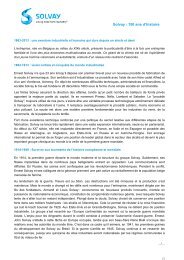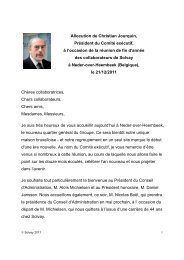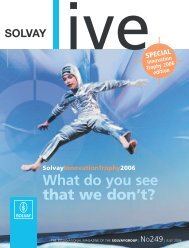Pharmaceuticals Sector - Solvay
Pharmaceuticals Sector - Solvay
Pharmaceuticals Sector - Solvay
You also want an ePaper? Increase the reach of your titles
YUMPU automatically turns print PDFs into web optimized ePapers that Google loves.
9. Impairment<br />
Every year the Group carries out impairment tests<br />
on goodwill. At each balance sheet date, the Group<br />
reviews the carrying amounts of investments and<br />
tangible and intangible assets to determine whether<br />
there is any indication that any of these assets might<br />
have suffered a reduction in value. Where such<br />
indication exists, the recoverable amount of the asset<br />
is estimated in order to determine the extent of the<br />
impairment loss. The recoverable amount is the higher<br />
of the fair value less costs to sell the asset and its value<br />
in use. The value in use is the net present value of the<br />
estimated future cash fl ows from the use of an asset.<br />
The recoverable amount is calculated at the level of<br />
the cash-generating unit to which the asset belongs.<br />
Where the recoverable amount is below the carrying<br />
amount, the latter is reduced to the recoverable<br />
amount. This impairment is immediately charged to<br />
the income statement as a non-recurring item. Where<br />
a previously recorded impairment no longer exists, the<br />
carrying amount is partially or totally re-established<br />
through non-recurring items, except in the case of<br />
goodwill, where the write-down cannot be reversed.<br />
10. Inventories<br />
Inventories are stated at the lower of purchasing<br />
cost (raw materials and merchandise) or production<br />
cost (work in progress and fi nished goods) and net<br />
realizable value. Net realizable value represents the<br />
estimated selling price, less all estimated costs of<br />
making the product ready for sale, including marketing,<br />
selling and distribution costs. Inventories are generally<br />
valued by the weighted average cost method. Cost<br />
of inventories includes the purchase, conversion and<br />
other costs incurred to bring the inventories to their<br />
present location and condition.<br />
11. Financial instruments<br />
- Trade receivables<br />
Trade receivables are stated at their nominal value less<br />
estimated non-recoverable amounts.<br />
- Listed fi nancial investments<br />
Listed fi nancial investments not considered as<br />
trading assets (securities available for sale according<br />
to IAS 39) are valued at the stock market price on<br />
each closing date. Unrealized profi ts and losses are<br />
recorded directly to equity.<br />
When such assets are sold, any profi t or loss already<br />
taken into equity is then included in the net income for<br />
the period.<br />
- Bank borrowings<br />
Bank loans and overdrafts are accounted for in<br />
the amount of the net proceeds received. Financial<br />
charges, including any settlement or redemption<br />
premiums, are charged over the term of the facility.<br />
- Trade liabilities<br />
Trade liabilities are stated at their nominal value.<br />
- Derivative fi nancial instruments<br />
Derivative fi nancial instruments are initially recorded<br />
at cost and re-measured to their fair value at every<br />
closing date. Changes in fair value linked to designated<br />
and effective cash fl ow hedges are recognized<br />
immediately in equity. Changes in fair value not linked<br />
to cash fl ow hedging operations are recorded in the<br />
income statement.<br />
- Cash and cash equivalents<br />
The cash and cash equivalents heading consists of<br />
cash and sight deposits, short-term deposits (under 3<br />
months) and highly liquid investments which are easily<br />
convertible into a known cash amount and where the<br />
risk of a change in value is negligible.<br />
12. Provisions<br />
A provision is set up whenever the Group has a legal<br />
or implicit obligation at the balance sheet date:<br />
- resulting from a past event and<br />
- which is likely to result in charges and<br />
- where the amount of such charges can be reliably<br />
estimated.<br />
Commitments resulting from restructuring plans are<br />
recognized at the time these plans are announced to<br />
the persons concerned.<br />
13. Segment information<br />
Segment information is produced according to two<br />
distinct criteria: a primary criterion based on the<br />
Group’s <strong>Sector</strong>s of activity, and a secondary criterion<br />
based on the main geographical regions.<br />
14. Revenue recognition<br />
A revenue is recognized once it is probable that it will<br />
be acquired and its amount can be reliably measured.<br />
Net sales consist of sales to third parties, less trade<br />
discounts. They are recognized when the signifi cant<br />
risks and rewards attached to the ownership of the<br />
goods are transferred to the buyer.<br />
Dividends are recorded in the income statement<br />
when declared by the Shareholders’ Meeting of the<br />
distributing company.<br />
<strong>Solvay</strong> Global Annual Report 2005<br />
63




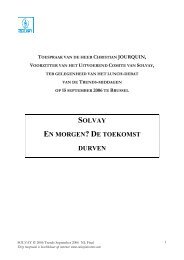
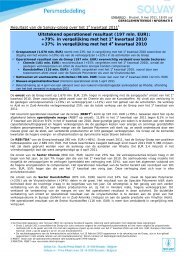

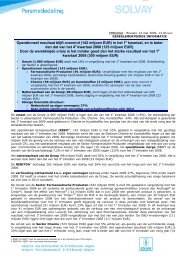
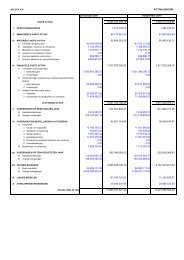


![PROC.1 [LETTRE] - Solvay](https://img.yumpu.com/16585746/1/184x260/proc1-lettre-solvay.jpg?quality=85)
